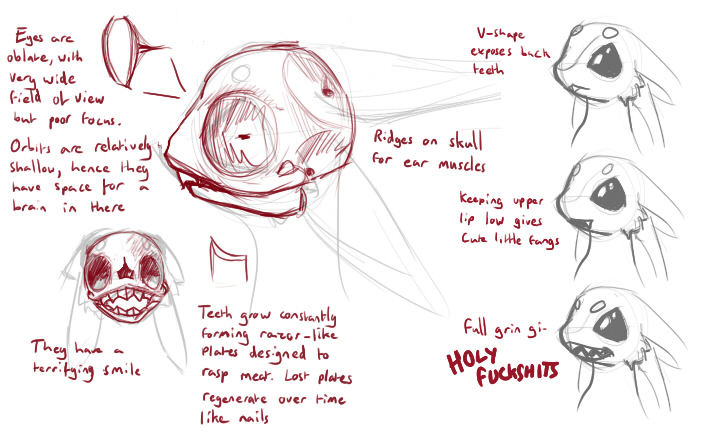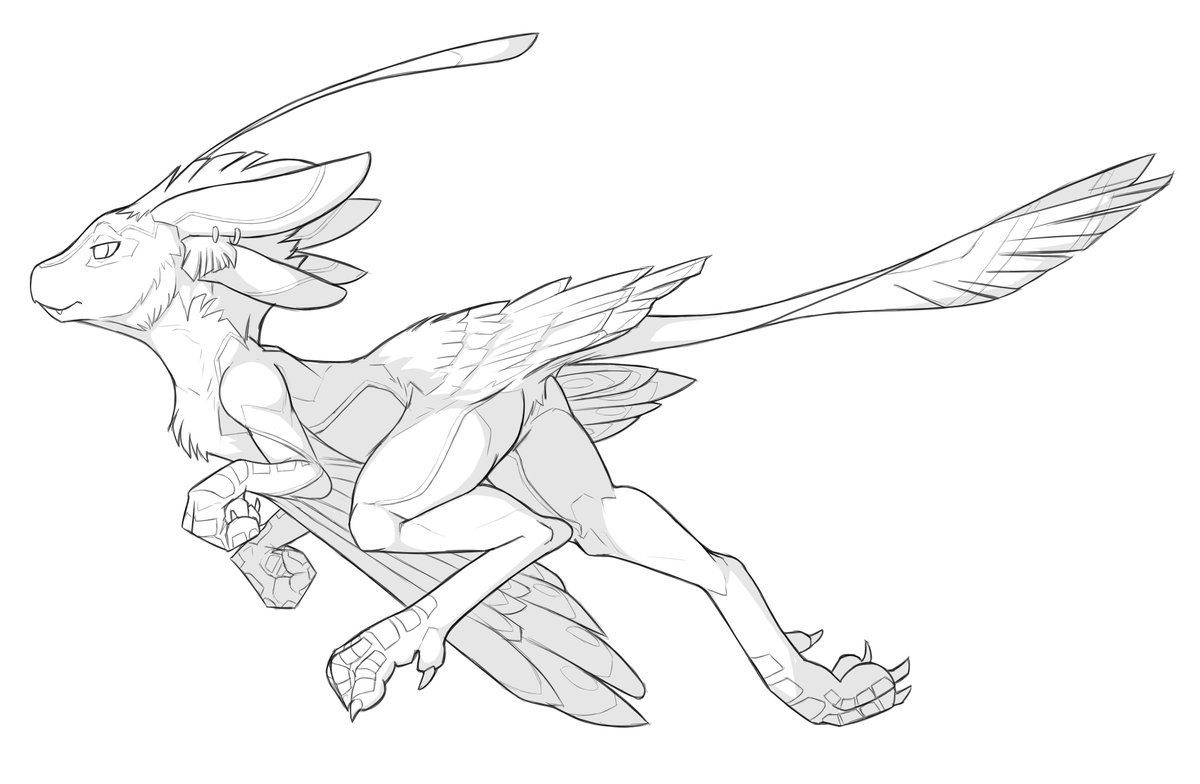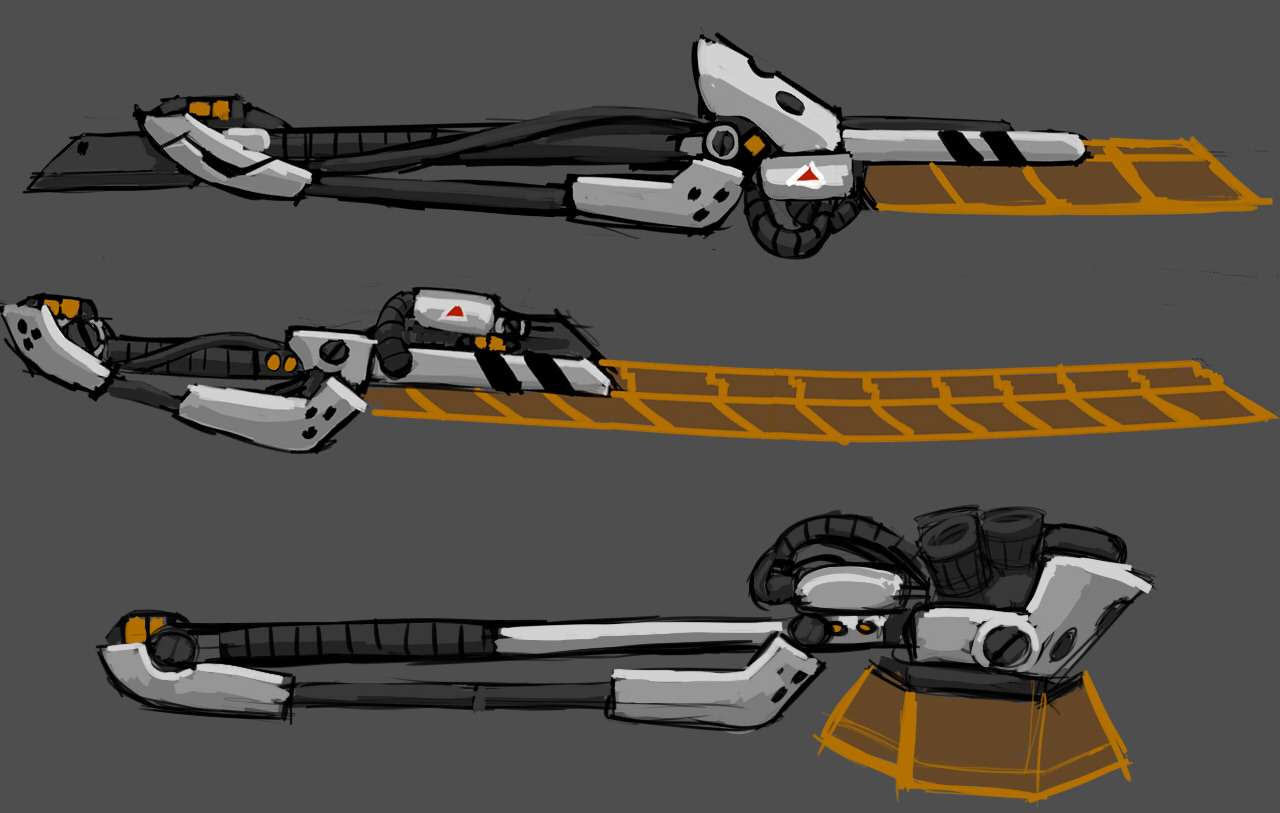Teshari are a sentient, bipedal race of small avians, originating from the tundra planet Sareshi, in the same star system as Qerr’balak, the Skrell homesystem. With very little sexual dimorphism, it can be hard to tell the genders apart. They are naturally able to endure very cold climates and organize themselves in packs. After some initial problems with the Skrell, they came to an agreement and reached for the stars together, thus becoming known with the other races. Teshari are rather fragile when compared to most sentient species and thus are not commonly employed in jobs that involve a risk of injury, like most combat-related jobs. They are naturally rather fast and often try to use their mobility to not get harmed.
Biology
Most Teshari stand between 3’5” and 4’0” tall (~1-1.2 meters), and laid out, 1.5 to 1.8 meters from nose to tail tipand weigh around 30 to 40 lbs. Their body appears to be mostly avian, but with a snout like that found on some reptiles. As such some tend to call them “Feather Raptors”. Teshari are bipedal creatures with digitigrade legs and a long tail which acts as a counterbalance. Compared to humans, they are very fast runners, able to easily jump over benches and tables while at full sprint, but they are rather fragile. While their hollow bones are allowing them to stay lightweight enough to glide on their home planet, they do not allow for a lot of resilience.
Teshari are naturally comfortable with very cold climates. They can survive in temperature ranges between 180K (-93°C, -135°F) and 320K (46°C, 116°F), but will need protective gear outside of that range. They can also comfortably breath and survive out of a pure oxygen bottle set to only 16 kPa, unlike a human who needs a kPa of 21 with a pure oxygen bottle.
Teshari have four big ears, two on each side, and they are known for their very acute hearing. In fact, Teshari can accurately hear people moving on the other side of a wall. They are however not able to hear details, like a whispered conversation or the size of someone moving, any better than humans. However, thanks to their four ears, they can accurately hear if a sound is coming from above or below them. Their hearing is incredibly sensitive and very loud noises, like flashbangs, can more easily stun Teshari and might even cause a loss of hearing.
While Teshari have big, light-sensitive eyes, they are not able to see any better in darkness. Teshari are not blinded by normal lights, they are susceptible to sudden flashes, like that of a flash, laserpointer, or flashbang.
Their ability to glide, their acute hearing, which is also capable of hearing altitude distances, their incredible cold resistance, and their ability to sustain themselves on thinner air, leads to many scientists believing that the first Teshari originated from the mountain ranges in the arctic and tundra areas of their home planet. However, they quickly adapted and spread out into the surrounding areas.
Theshari have two genders, male and female, and reproduce sexually. A Teshari female will lay a single hardshell egg after roughly two months. Some females lay an unfertilized egg every two months, while others only produce an egg after getting fertilized. After a fertilized egg was laid, it takes five more months for the new Teshari to grow and break their shell. Hours after hatching, a Teshari is able to walk.
Sexual dimorphism between male and female Teshari is near-inexistent, making it almost impossible for non-Teshari to tell the difference between them. Especially so because their voices are rather similar. Female Teshari have no breasts or other immediate signs to easily identify them. At the same time, most Teshari don’t seem to differentiate between male and female Teshari when it comes to work and generally any activity other than sex.
Teshari are carnivores, as evidenced by their sharp teeth. They used to hunt game up to their own size, using pack tactics and very early tools and weapons to engage without exposing themselves to danger, using spears and slings in their early stages.
As the Teshari spread out over their home planet, multiple subspecies of Teshari evolved:
The Homeward subspecies is also the most common one, the baseline. They live in the tundra region, which covers the biggest parts of the planet, and as such grew to become the most common Teshari subspecies. Among all the subspecies the Homeward were the first to establish permanent settlements.
The Thermic subspecies lived in the colder regions of the planet. Among all the Teshari, they are the smallest ones. Suited for the harsher and colder regions, they evolved to have fluffier feathers to insulate them from the cold even more and thus can sustain lower temperatures better than other Teshari.
The nomadic Farer subspecies never had one specific region. Instead, they always kept moving with their entire pack, moving from place to place, travelling all over the planet. They are of average height, but their wingarms have a stronger musculature, allowing them to keep flying for longer distances. The Farer are known for their nomadic lifestyle, their ability to easily make new friends wherever they go, and their focus on only carrying what is necessary. They were the last subspecies to settle down for more permanent housing, even though some of them keep saying that they are just taking a ten-generation-break before moving on.
The most unusual subspecies is the Virtic, who travelled to the equatorial area of the planet, to the warmest areas where the average temperature is roughly -15°C. The Virtic are taller than the other subspecies and built more sturdy, but in turn can use their wings only for short distances.
Psychology and Sociology
Most Teshari are organized in packs, and basically their entire social life revolves around and among the pack. It’s important to note that in most packs, family has little meaning. The young are raised by the pack as a whole, the natural parents of a Teshari might hold the position of a “favourite aunt or uncle” though. The raising of a child Teshari is a communal task for the entire pack. Everyone is supposed to watch over the young, play with them, teach them what they need to survive, and similar.
In the eyes of many Teshari, the pack is the most important in their life. They will go out of their way to stick to their pack and strife to improve the situation for all of the pack whenever possible. In the past, those who were not utterly devoted to their pack were seen as weird and mentally ill. The various packs among Teshari are often structured quite differently. While some packs might have one clear leader, others might have a tribunal, or just communaly decide on important topics together. There is no clear trend between the various packs, but in more recent history, as Teshari formed towns and cities, packs became ever larger, sometimes encompassing an entire building block.
Most packs share that there is little privacy. Given the cold climate Teshari originate from, it became common to not have a room with a bed for every person or pair, but instead have large communal sleeping rooms where they cuddle up together to share each other’s warmth. Among many packs this has lead to a very carefree attitude regarding physical contact, like hugging and cuddling, but it also is not uncommon for male and female Teshari to mate in these shared rooms. Similarly, some packs tend to stay monogamous, but many packs are polyamorous.
In their past, Teshari tribes often felt a very strong urge to protect each other. While useful in the past to make sure that a single Teshari would still be cared for when hurt or sick, this has caused some problems in the more enlightened times, with Teshari packmates forming up to try and help another packmate, even if that one has committed a crime and is being locked up by the police or various station security. This has lead to some problems, but both Teshari and Skrell soon learned that it’s best to get the pack involved in the prosecution so the pack as a whole agrees that the single packmember has done something wrong, rather than trying to keep them away from all trials and not inform them.
The various Teshari subspecies still see each other as Teshari, and thanks to their social lifestyle usually aren’t outright hostile towards other Teshari races. But even though outright hostility isn’t the usual case, the different races still have some prejudices attached to themselves.
Compared to the Homeward, all three other races like to point out how they are better in something. Thermic will point out that they have a much easier time in the colder regions. Farer will happily point out that they can fly better, faster, and further. Virtic like to flex on Homeward by simply using their larger body to place their chin on top of a Homeward’s head.
With Thermic, the other races like to say that they were simply too slow and thus had to go further into the coldest areas, because all the good places were already used up. In reality, the Thermic are the species who are the fastest at running.
With Farers the other races like pointing out that, by now, the Farers, are basically just like the Homeward. And sometimes a pack of Farers will simply move from one hab block to another just to spite the others in return. Regarding the Virtic, most other races… say nothing. They simply nod and wait for the big Teshari to move out of earshot before talking about how the Virtic are the slowest and that they only got so large because, unlike the rest of the Teshari, they didn’t need to evolve in the same hardship as their ancestors, but instead had the easy way.
Nowadays, cities and settlements contain Teshari of all four races. Sometimes there are even multiple races within a single pack. This though is unusual, but not unknown of. The various races live together and share the same hopes, worries, and dreams. Past some friendly bickering, no one race is treated vastly different than the other.
History
In their beginnings, Teshari lived as nomadic tribes in the mountain and tundra regions encompassing their home planet Sareshi. They hunted small game and used pack tactics to help each other and survive, often living in caves and later on in makeshift buildings made of snow, ice, and whatever they had available. Because of the cold weather, farming was barely ever possible, as such few tribes even attempted. The first permanent settlements formed on the shorelines, where Teshari hunted for fish, by using spears and nets. Once the first tribes managed to get a stable food source by means of fishing, the tribes grew steadily.
Because of the lack of wood in the tundra regions, there was little building material for ships. Thankfully though, with the planet's low gravity, Teshari were able to use their wingarms to fly, and as such the first groups spread out ever further over the planet. And as with most species, once they were able to build ever better tools, they were also able to gather more resources, thus allowing their settlements to grow.
As the Teshari developed and spread out, they advanced in technology. While wood was scarce, they were able to set up quarries and soon they started building with stone and metal. With the technological advancements, traveling became easier and as such the Teshari also spread out to both the warmer and the colder areas of the planet. Especially in the warmer areas they were finally able to grow crops and set up farms. With more and more ways to secure a steady food supply, the Teshari population boomed, and soon these previously nomadic tribes, living from hunting small game, turned into towns and cities with their own food production. Naturally, there was conflict among Teshari, with some tribes fighting one another. And as always, conflict leads to innovation, causing Teshari technology to gradually advance from spears and slings, to swords and bows, and later on to the first musket.
As the Teshari got into their industrial age, as they advanced their technology further and further and made the first radios, especially once radio stations were broadcasting songs and news over entire continents, it came to be that some Teshari groups, those with the necessary equipment, received messages where the sender was unknown. This caused some curiosity, but no one knew if those were actual messenger, or just distorted radio transmissions from the other side of the planet. However, with time, the messages became clearer, turning from simple static to a series of tunes. Some scientists repeated that series of tunes and sent the message back. Soon after it showed that the message didn’t come from some unknown radio station on this planet, but from another planet, and the Teshari realized that they were not alone in this solar system.
The following commotion was huge, every Teshari tribe had an opinion on what to do regarding those aliens, and everyone wanted their opinion to be heard. It took a while, but the overall consensus was that communication with other species was good and should be continued. Some tribes held onto their belief that those aliens had to be mistrusted, but they were in the minority.
As communication continued, the Teshari and Skrell learned to communicate with each other better, made first translators, learned each other’s language, and started communicating openly. They shared information, technology, and in the end even news. Some radio stations intentionally broadcasted their shows to the other planet, and thus a cultural exchange started.
After years of communication, not only between scientists but also between the common folk, things started to go bad. During the entire time, some Skrell and some Teshari groups had tried to sabotage the joint effort between the species, but nothing was as bad as when a large war started on Qerr’balak. A war so big, it was raged on roughly half of the planet’s surface. As false information was spread from multiple people, it only fueled the already existing sabotage attempts. The end of the war showed, for all Teshari to see thanks to video transmission, how the Skrell had developed a weapon of massive destructive potential. A technology the Teshari didn’t have yet. A nuclear bomb.
Some Teshari called that all contact with the Skrell had to be stopped, given how their fear of Skrell using nuclear weapons to subjugate the Teshari species. Some Teshari, especially those who were already opposed to the Skrell, demanded that all Teshari must focus all their research on gaining nuclear technology to use them in a pre-emptive strike against the Skrell, believing that the Skrell were surely going to strike them if they didn’t strike them first.
Thankfully for both species, most Teshari decided that they have to continue with peaceful relationships, and as such they stayed in positive contact. This led to the Skrell visiting Sareshi, the Teshari home planet, and from there on, both the Skrell and Teshari expanded in the solar system as the Skrell willingly gave them the technology needed to build spaceships. And as the Skrell rediscovered FTL travel, they also gave this technology to the Teshari, with whom they formed the Vikara Combine. Some tribes, who disliked seeing the Teshari species founding the Vikara Combine together with the Skrell, used the recently acquired FTL technology to travel far away and start their own nation.
Not everything went well as the Teshari, as part of the Vikara Combine, reached for the galaxy. Some hiccups happened along the way, namely, when the Skrell first took a Teshari Diplomat with them to introduce them to the other races, one of the ambassadors assumed that the Teshari was a pet brought along. A Teshari delegation was once sent to meet the Clown Planet. The so-called “Rubber Chicken Incident” is the resulting incident, where no information seemingly exists beyond heavily redacted incident reports. In fact, all most would know of the incident is the name itself.
On some planets and colonies, Teshari were sometimes almost, and sometimes actually attacked by the local colonists who assumed that they were some sort of hostile alien. Some people started to jokingly call Teshari chickens, and some species started to joke about them probably tasting like chicken, which led to some of the harsher communities out there, like Vox Pirates and Unathi militants, to actually test this theory. A very controversial book by the Vox Marauder Yacharaka, called “23 Kind of Teshari Dinner” was published, and were it not for the almost-immediate ban of this book which glorified murder, no one would have read it. It's immediate ban triggered an almost immediate underground following, and copies are still available on isolated exonet servers.
But in the end, no species has an easy beginning when meeting the other spacefaring races and becoming part of the galaxy as a whole. And with that in mind, it is remarkable that the Teshari have managed to bounce back from such a first impression.
Today, Teshari often work in professions where intelligence and wits are needed more than muscle strength, but with modern tools there are still Teshari Miners and Security Officers.
Technology and Popular Media
Teshari and Technology
As Teshari evolved on their home planet, they soon used primitive spears to hunt. While they quickly got primitive tools like spears or using stone fragments as knives, the Teshari had a hard time getting proper wooden tools due to a lack of wood.
After the Teshari managed to tame the fire and use it, they had a technological boom similar to most sentient species. They built furnaces to smelt metal, casting and smithing tools, sustaining themselves with farming and fishing. Like most sentient species, compared to what seems to be the galactic standard, the Teshari made metal tools, better housing, better furnaces, and used water, wind, and steam to power contraptions. The ability to use metals for tools was actually a saving grace as wood for handles was quite rare. The Teshari advanced quickly and soon had their first radio. As the Radio technology spread over the planet, a deciding moment happened in Teshari history as they got in contact with the Skrell. However, since both species shared each other’s scientific discovery, they both advanced quickly.
Following the unification with the Skrell, with the two species forming the Vikaran Combine proto-federation, the Teshari achieved another technological boom, during which they made many advances, but specifically achieved two technological feats, detailed below. Theshari are known to be intelligent and cunning, resourceful and ingenious. They are adept at not only finding new technology, but also adapting the technology of others, and using such technology for entirely new applications. However, when Teshari are constructing tools for themselves, they always make sure that all the tools can easily be wielded or Teshari sizes, that their technology doesn’t require more than three fingers at once, and on Teshari ships and stations one will often find that rooms are cooled down to lower temperatures and hat there are a lot of step-ladders.
Repulsor Technology
One of the technological marvels by Teshari is the Repulsor technology. Original concepts started with the idea of using magnetic waves. However, when the Skrell shared their back-then newly discovered Ion Thruster engines with the Teshari, many Teshari scientists and engineers saw the potential and used them in vastly different fields. Nowadays, most Repulsor technology are miniature vector-thrust Ion engines linked to a miniature computer with gyroscopic sensors, allowing for automatic stabilization. Various vehicles have been outfitted with them, and soon it became standard in the Vikaran Combine to have shuttles and ships outfitted with such Repulsor thrusters, not with the purpose of using these as a vehicle’s main propulsion, but to allow those vehicle to hover. Soon after, the technology has been adapted to work for cargo crates. Even belts with such thrusters were made, but they are too expensive for most people to be commercially viable. And the fact that such repulsor belts were usually controlled by the natural inputs of a Teshari’s tail, made them pretty unpopular with other races.
Holoforge Technology
In an attempt to have ever lighter tools with as little maintenance as possible, some Teshari scientists made breakthroughs in holoforge technology. By projecting energy fields in specific shapes, those holoforge tools create forms which are then flooded with matter cartridges. Those matter cartridges are filled with a powder mix of multiple materials, but mostly out of powdered crystalline metals. When the energy field is created, the powdered material flows out of the cartridge and flows into the form to coat the surface of the form, creating a hollow shape. While this shape isn’t the most robust, it’s good enough and the energy field can create fine details like screwheads and edges, allowing the creation of universal screwdrivers able to form any head desired, or the creation of a sharp blade. Damages to the form can easily be repaired by retracting and then reforming the shape. The contents of such matter cartridges are usually transparent when under the effect of the electrical field of the tool’s form, but the interaction of the powder and the electrons creating the field cause the powder to light up and glow, thus creating a glowing yellow/orange field, with brighter lines where the most electrons interact. Some of the most usual applications for this technology are tools that allow the user to get a wide selection of tools (often including a little camera to scan a screw and thus create a screwdriver perfect for this screw), or for knives, swords, and other blades. Especially in the human worlds people are very interested in buying swords with holoforge technology.
With the energy field deactivated, the matter retracts back into the matter cartridge (which has to be replaced every now and then, along with the power cell), which allows the user to carry around less. However, given how concealable a knife or sword like that can be with the blade retracted, a lot of Security dislikes seeing such items. And given that the matter only forms a hollow shape, it’s not very good to be used for shields.
Teshari in Popular Culture
With their relatively recent addition to the galaxy as a whole, Teshari have seen an uprising in media attention. While rarely portrayed in the role of the solitary hero, they are often found as sidekicks, fitting that role thanks to their strong pack structure and serving as loyal helpers. They are also often seen in roles that require wits, like in “Ocean’s 34” where a Teshari serves as the teams hacker during a heist.
In stark contrast is the movie “Cold Blood”, which focuses on Teshari's speed and ability to survive in cold environments. In this horror movie, where a team of mercenaries come to the aid of colonists on an arctic world, Teshari are portrayed as cruel and efficient hunters, striking when they deem it right and thus strike fear into the colonists. During the course of the movie, one after the other of the mercenaries gets dragged off into the cold arctic and is presumed dead, until in a big twist it is revealed that the Teshari kidnapped them to ask for their help against the colonists, who destroyed their settlements.
Author: C0rtana (Alina)
Galactic Species
| |
| Common Species | Humans, Synthetics, Skrell, Tajara, Teshari, Unathi |
| Uncommon Species | Akula, Alraune, Auril, Dremachir, Naramadi, Zaddat, Dnin-Nepids |
| Whitelisted Species | Adherent, Dionea, Phoronids, Proteans, Shadekin, Vox, Xenochimera, Xenohybrids |
| Misc Species & Data | Minor Races, Scori, Changelings |




